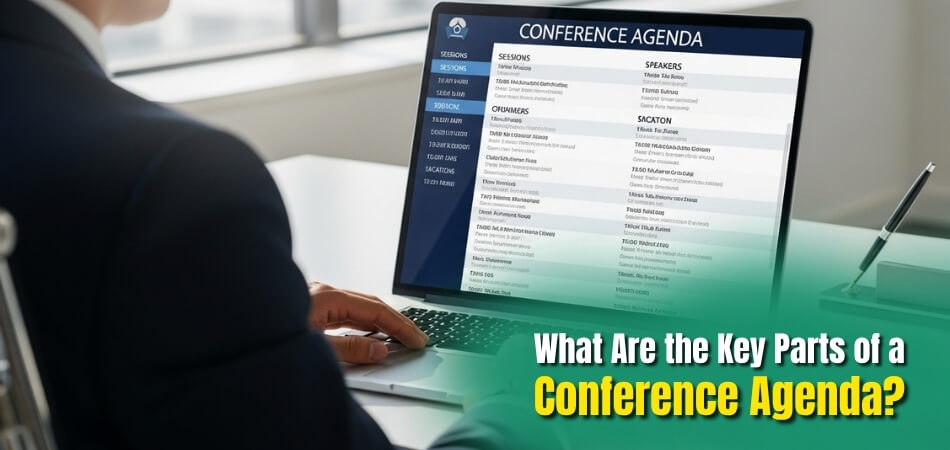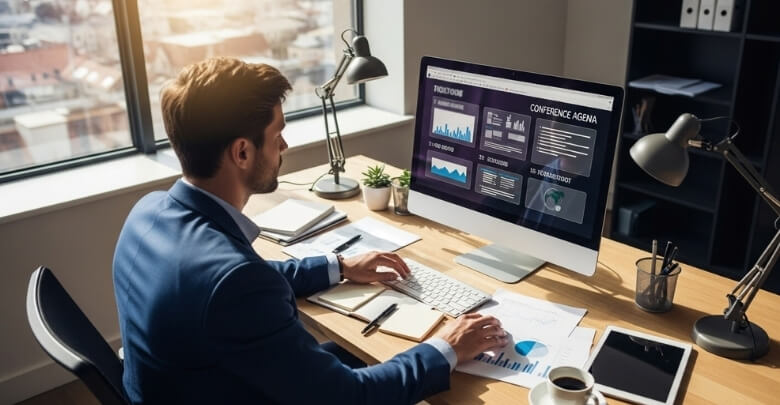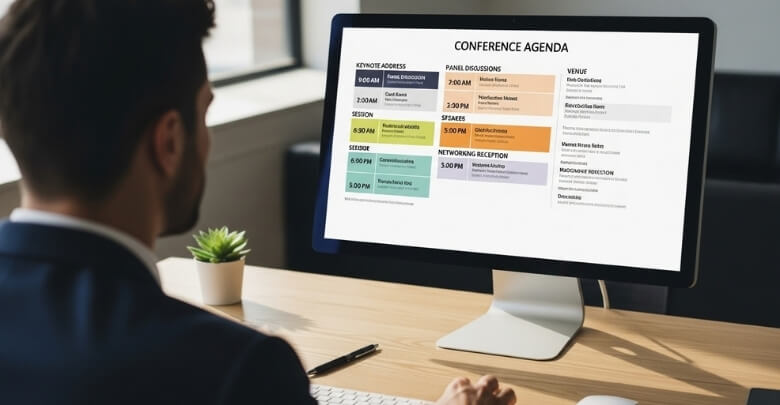A good conference agenda sets the tone for a well-organized event. It shows the flow of sessions, speakers, and activities in a clear order that keeps everyone on track. You might be planning an event or just wondering what makes one run smoothly, and now you want to know what are the key parts of a conference agenda?
The key parts of a conference agenda include basic event information, session schedules, speaker lists, breaks, networking times, workshops, and special events. It also features opening and closing remarks. These sections keep the event organized, engaging, and easy for attendees to follow.
Do you want to explore how each part of a conference agenda fits together? Keep reading, and you’ll find every important detail you need to plan or understand a well-structured and engaging conference schedule.
What Are the Key Parts of a Conference Agenda?
A clear conference agenda helps everyone stay on track and prepared. It gives a full view of the event and its timing. Attendees can plan their day and know what to expect next. Read below to learn all the main parts that make a good conference agenda.

Basic Event Information
Every agenda should start with the main event details. It includes the event name, full dates, and location. Mention the exact venue address and room names if needed. Also, list contact information for the main organizer in case anyone needs help.
Session Schedule and Speakers
The session part gives a full plan of the day’s flow. It lists each session title, speaker name, and start and end times. This helps attendees move between sessions easily. Especially for big events like upcoming conferences in USA, Canada, or any other country, a well-made schedule avoids confusion.
Breaks and Networking Time
Short breaks between sessions keep people refreshed and alert. Meal breaks, coffee times, and open networking slots are helpful. These breaks allow people to talk, share ideas, and build good connections. Good agendas always balance learning time with relaxation.
Workshops and Interactive Sessions
Many events include workshops, Q&A rounds, or hands-on tasks. These help people take part and learn through real practice. Listing these sessions with times and topics helps attendees pick what interests them most. Interactive parts often become the highlight of the day.
Special Events and Social Activities
Some conferences include evening parties, award shows, or meetups. Adding them to the agenda keeps everyone aware of extra fun events. It also helps guests plan travel or rest time better. Small notes about dress code or transport are also useful here.
Opening and Closing Remarks
Agendas usually begin with a short welcome speech and end with final remarks. The opening gives an overview of the event’s goals. The closing helps sum up the main points and thank attendees. It gives a proper start and finish to the full experience.
A well-structured agenda makes a conference run smoothly and clearly. It guides both guests and speakers throughout the event. It also builds a sense of order and excitement for what’s ahead. Make sure your agenda includes all these parts for the best results.
How to Arrange the Key Parts in a Conference Agenda?
Planning a conference needs a clear and simple order of events. Each part of the day should connect smoothly to the next. When the flow is right, people feel comfortable and engaged. Let’s go through how to set it up step by step so your event runs perfectly.
Opening and Welcome
Start the day with a warm greeting to everyone attending. Introduce the purpose and goals of the event in a short, clear way. This part helps people relax and understand what’s coming next. When arranging sessions, it helps to first understand the structure of a conference agenda, so every part flows smoothly from start to finish.
Keynote or Plenary Session
After the welcome, begin with a strong main session. This is usually a talk from an expert or special guest. It connects everyone to the main theme and sets the energy for the day. A good keynote keeps people interested and excited for the rest of the sessions.
Break and Networking Time
After a long talk, give people time to rest and chat. Short breaks are great for coffee, snacks, and small conversations. It helps everyone refresh their mind and get ready for the next topic. A relaxed break also encourages people to make new connections.
Themed Sessions, Panels, or Workshops
This is the core part of the conference where learning happens. Divide into smaller groups or sessions based on topics. Let people join what interests them most. It’s a good time for active talks, discussions, and idea sharing among participants.
Lunch or Midday Break
Food breaks are just as important as sessions. A nice lunch helps people regain energy and enjoy informal talks. It’s also the perfect time to meet others and exchange ideas. A happy lunch hour keeps the mood positive for the rest of the day.
Afternoon Sessions
Use the afternoon for deeper discussions or special workshops. Try to keep the topics varied so the energy stays up. If the sessions are interactive, people will stay focused. Avoid heavy lectures during this time, as people may feel tired.
Short Refresh Break
Before the final session, add a short break. It can be ten to fifteen minutes long. This small pause gives people time to stretch, check messages, and relax. A short refresh helps them stay alert and ready for the closing.
Wrap-up and Closing Session
End the day by bringing all the key points together. Thank everyone, share final thoughts, and highlight what comes next. A good closing leaves people inspired and satisfied. You can also invite a guest to end with a motivational message.
Social or Networking Event
After the official program, add an optional social time. It can be a small reception or a casual meet-up. This allows people to connect freely and share ideas. It’s often where the best conversations and partnerships begin.
Why This Order Works
Starting strong helps set the tone early in the day. Placing breaks between sessions keeps people fresh and alert. The middle part covers deep learning and interaction. Ending with a summary ties everything together neatly. A friendly social session at the end leaves a lasting, positive impression.
A well-planned conference feels smooth and easy for everyone. Each section supports the next without confusion or rush. The right order keeps people engaged from start to finish. Follow this flow to create a balanced and enjoyable event for all.
How Much Time Should Each Part of the Conference Agenda Get?
Planning how much time to give each part of your conference helps keep the event smooth and engaging. It also ensures attendees stay focused and enjoy every session without feeling rushed or tired. Here’s how to divide the time wisely.
- Opening / Welcome: Keep it short and friendly, between 5 to 15 minutes. This part sets the mood, gives basic info, and helps guests feel comfortable before main sessions begin.
- Keynote / Plenary: Give around 30 to 60 minutes. It’s often the highlight, so allow enough time for deep insight, stories, and interaction without tiring the audience.
- Breaks / Coffee: Plan for 10 to 20 minutes. People need short pauses to relax, chat, or refresh before getting back to sessions with better focus.
- Lunch: Allow 45 to 90 minutes depending on the crowd size. A calm lunch break helps attendees recharge and network before returning to the next part.
- Workshops / Sessions: Schedule 45 to 90 minutes for detailed sessions. For short “lightning” ones, go for 20 to 30 minutes to keep attention and energy high.
- Panel & Discussion: Aim for 30 to 60 minutes. This gives enough space for multiple speakers to share ideas, have Q&A, and wrap up nicely.
- Closing / Wrap-up: Use 10 to 20 minutes. This is your chance to thank everyone, share next steps, and end the day on a positive note.
- Social / Networking: Keep this flexible, from 30 minutes to over an hour. It allows guests to connect, share contacts, and enjoy casual talks.
A well-timed agenda keeps your event smooth and enjoyable. Always add small buffers for breaks or transitions, and remember that a balance between long sessions and short breaks keeps everyone alert and happy.
How to Customize the Key Parts of a Conference Agenda for Different Events?
A good conference agenda helps everyone know what happens and when. It makes sure sessions, speakers, and breaks all run smoothly together. Different event types need different setups to work well. Keep reading to see how to customize the key parts of a conference agenda for each event type.
Academic Conferences
Learning and sharing ideas are the main focus of these events. Sessions often include research papers, poster displays, or short talks. Presentations usually last 20 to 30 minutes with Q&A time. Many have parallel sessions, so more topics can fit in. Planning longer discussions helps people dive deeper into their subjects and share clear feedback.
Business or Industry Conferences
The goal here is to learn from experts and make useful connections. Agendas often include keynotes, trend talks, and live panels. Organizers may add hands-on workshops or product demos. These events work well with flexible breaks for networking or sponsor sessions. Fewer but longer sessions keep things focused while giving time for group learning.
Virtual or Hybrid Conferences
Online events need shorter, engaging sessions to hold attention. Organizers should plan 20 to 45-minute sessions to reduce screen tiredness. Adding polls, chats, or breakout rooms keeps the audience active. Recording sessions helps people in other time zones watch later. Small breaks between sessions also help with smooth transitions and tech setup.
Mixing Different Formats
Many modern events blend live, recorded, and online parts together. This mix allows more people to join easily from different places. A balanced schedule keeps both in-person and online guests engaged. While every event may have its own style, the main elements of a good conference agenda, such as clear structure, balanced timing, and engaging sessions, remain important across all formats.
Adding Networking and Social Time
Conferences also bring people together to meet and connect. Organizers can add casual chats, meetups, or after-session breaks. Academic events can use poster walks or lunch talks for this. Business ones often include mixers or product showcases. Even virtual events can use chat lounges or group calls to build friendly connections among guests.
Making a strong agenda means understanding what your event truly needs. Keep sessions balanced, clear, and easy to follow for everyone. Focus on simple timing and smooth planning across all event types. With the right setup, any event can run well and keep people engaged throughout.
Tips to Make Each Part of the Conference Agenda More Engaging
Making a conference agenda engaging helps keep everyone active and interested throughout the day. You can add simple but creative elements to make each session enjoyable, meaningful, and full of energy for both speakers and participants. Here are practical ways to make every part of your conference agenda more dynamic and interactive for attendees.
- Q&A Time: Let people ask questions right after each talk. It gives everyone a chance to speak up and clears any doubts while keeping the session interactive and lively.
- Interactive Elements: Use live polls, small quizzes, or quick feedback tools. These help the audience stay alert, give instant reactions, and make learning more active and fun.
- Breakout Sessions: Divide participants into small groups for short discussions or activities. This setup helps everyone share ideas, solve small problems, and connect with new people easily.
- Icebreakers or Energizers: Start or restart sessions with short, fun tasks. It could be as simple as sharing one idea or greeting a new person near them.
- Lightning Talks: Include short talks that last about five to seven minutes. This keeps attention high and adds variety to the agenda without making people tired.
- Mix Session Types: Plan a mix of lectures, panels, and discussions. This variety keeps participants curious and prevents the day from feeling repetitive or slow.
- Short Breaks: Add small breaks in long sessions. Even five minutes for stretching or reflecting helps people stay focused and refreshed for what comes next.
- Storytelling and Visuals: Encourage speakers to use real stories, photos, and examples. This makes their message easier to understand and helps people connect emotionally with the content.
- Audience Participation: Let attendees share quick thoughts or short experiences. When people get to talk, they feel valued and more connected to the discussion.
- Gamification: Turn learning into a friendly competition with points or small prizes. A little fun challenge makes everyone more active and motivated to take part.
- Feedback and Reflection: At the end of major sessions, ask participants to share one key takeaway or fill out a short survey. It helps improve future sessions as well.
- Networking Breaks: Plan breaks where people can talk easily, maybe through topic tables or quick introductions. This makes networking feel natural, not forced.
- Active Moderator or Host: Choose a lively host who can guide transitions, keep energy up, and build excitement for what’s next on the agenda.
With these simple ideas, every session in your conference can feel engaging and smooth. A balanced mix of fun, interaction, and learning ensures everyone leaves with great memories and valuable connections.
FAQs About What Are the Key Parts of a Conference Agenda?
Here are some common questions people often ask about planning and understanding a conference agenda. These FAQs will help you learn more about how to organize, manage, and improve different parts of your event.
How Can I Make My Conference Agenda Easy to Read for Everyone?
A good agenda should be simple, clear, and well-organized. Use short titles, readable fonts, and keep session details in order. Avoid using too much text or confusing layouts. Add color or icons to mark different sessions or breaks, so people can find what they need quickly.
Why Is It Important to Share the Agenda Before the Conference?
Sharing the agenda early helps people plan their day better. Attendees can choose which sessions they want to join and prepare their questions. Speakers can also adjust their presentations based on the time and audience. It reduces confusion and keeps everyone ready before the event starts.
What Should Be Included in the Agenda Description for Each Session?
Each session should have a clear title, a short summary, and the speaker’s name. Add the time and location so people know when and where to go. If possible, mention what attendees will learn from the session. This helps them decide which sessions are most useful to attend.
How Can I Keep the Conference Agenda Flexible for Changes?
It’s smart to leave small time gaps in your agenda for unexpected delays. Use digital tools that allow quick updates or notifications to attendees. Always have a backup plan for sudden changes like late speakers or technical problems. Flexibility keeps the event smooth, even when things shift last minute.
How Detailed Should the Conference Agenda Be?
The agenda should have enough detail to guide everyone without being too long. Include only key information like times, titles, speakers, and breaks. Avoid adding full bios or long session descriptions in the main schedule. You can link to extra details separately if needed.
How Can Technology Help in Managing a Conference Agenda?
You can use event apps, websites, or digital boards to share updates in real time. These tools let attendees check sessions easily on their phones. Some apps even send reminders or show maps for the venue. This makes everything more organized and saves paper as well.
What Is the Role of a Moderator in the Conference Agenda?
A moderator helps keep each session on time and organized. They introduce speakers, manage audience questions, and ensure smooth flow. Their presence helps reduce confusion and keeps the session energy steady. A good moderator makes sessions more enjoyable and professional.
How Early Should Organizers Finalize the Conference Agenda?
It’s best to have a final draft ready at least two to four weeks before the event. This gives time to review, adjust, and share with all speakers. Early planning also helps print materials or set up digital updates. Finalizing early avoids stress and last-minute mistakes.
How Can Organizers Handle Overlapping Sessions in the Agenda?
If sessions happen at the same time, group them by theme or interest level. This helps attendees pick easily based on what they care about. Provide clear directions to different rooms to avoid confusion. Also, share recorded sessions later so no one misses anything important.
What Is the Best Way to End a Conference Agenda?
Always finish with a closing session that summarizes key points of the day. Thank everyone for joining and share any follow-up plans or future events. A short thank-you note or feedback session also works well. Ending on a warm and positive note leaves a lasting impression on everyone.
Final Words
A good conference plan keeps the whole event smooth and enjoyable. It guides speakers, guests, and sessions in a simple, clear way. Every part, from opening to closing, matters for success. Now you know what are the key parts of a conference agenda.
Planning ahead, keeping sessions short, and adding breaks make a big difference. Let every session flow naturally and keep people engaged till the end. Always stay flexible, enjoy the process, and create great events. Wishing you all the best for your next conference!







